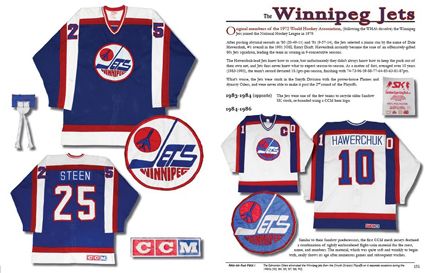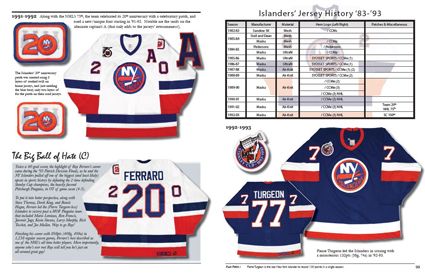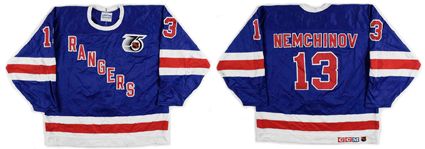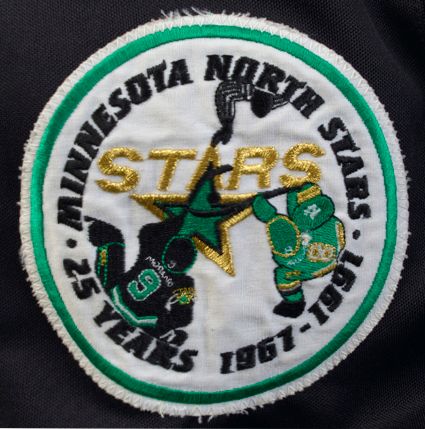TSG: Your book, The History of the Hockey Jersey 1983-1993 has recently been published. When did the project start? Was there a particular inspiration for doing it?
CD: Upon first glance, the most common question I receive from readers, is -
“Wow, how long did it take you to put the book together?”
I normally answer roughly two years, but truth be told, I’m not sure.
I started collecting hockey cards and comic books with my father when I was 12 years old, and by college I’d graduated on to hockey jerseys.
I originally collected anything and everything under the sun: the newest/hottest designs, the best players, patched jerseys of all sorts, but after recognizing that there will always be a new jersey to obtain, I decided to exhibit some discipline and refocus my collection. I then started researching the history of the hockey jersey, and noticed that the business of marketing was really beginning to clash with the culture and heritage of the jerseys starting in the early 80s, and increased throughout the time period of the book.
In the 60s and 70s, a lot of local suppliers and customizers helped create and ingrain signature colors, textures, designs, and style. Staring in the 1980s, several companies were fighting for the rights to supply NHL teams, and as a result we saw a relatively large variety of jersey styles, as well as materials and customization.
This lead to further marketing, the introduction of alternate jerseys, and by 1993, we began to see completely redesigned uniforms for certain teams, a trend that’s commonplace today. 1983-1993 truly was the golden age of jerseys.
TSG: You not only have examples of each type of jersey during that era, but the players whose jerseys are pictured are phenomenal. Are they all from your personal collection? Are they all game worn in the book? How many jerseys do you personally own?
CD: A good portion of the jerseys are still part of my personal collection, but several have since found new homes through buying/selling/trading with fellow enthusiasts. It tends be an ever revolving closet in this hobby, as most collectors can attest to.
The jerseys in the book are a mixed bag of gamers and game-issued, with a few pro authentics (done to team spec) in cases where no gamers were available. As a matter of fact, when I started putting the book together, despite having the bulk of what I needed in my collection, there were still several key gaps that needed filling to ensure I did the book service. For some of those I turned to the collecting community for help, and a few fellow collectors actually loaned me their jerseys temporarily, simply to be able to take pictures for the book. And how awesome is that? It’s testament to just how great some of the people are in this fine hobby of ours.
My only criterion for the book was that everything needed to be pro on-ice jerseys: no replicas, no semi-pros, nothing done by other companies or manufacturers, and, of course, no fake stuff.
Along the same vein, I should also point out that there are certain players that were (unintentionally) omitted from the book, simply because I’ve never come across said players’ jerseys. Trottier and Potvin in the Islanders chapter, for example, and I would have loved to have included Michel Goulet and the Stastny brothers in the Nordiques chapter, but some players didn’t make it in the book simply because I’ve never come across their jerseys in all my years of collecting.
TSG: It must have taken ages to not only photograph all those jerseys, but then outline them to prepare them for publication. Did you have a life while producing the book?
CD: I’m a public servant with the Canadian Federal Government by day (when in Rome…), and indulge in a variety of extracurricular activities during the week, including playing hockey twice a week - the latter being a priority. Maintaining a good balance between my professional and social lives, with that of the book endeavour, certainly wasn’t always obvious.
That said, I’m very fortunate that I didn’t have to do it alone and a lot of the credit should go to my production assistant, Hilary Chaiton, who spent a ridiculous amount of time helping me put things together. We often dedicated several nights a week, as well as entire weekends together working on the layout and design of the book. Hilary showed infinite patience throughout the entire process, accorded me some as well, and it’s not a stretch to say the book wouldn’t have come to fruition without her.
TSG: How has the book been received?
CD: Better than expected, I’m happy to report. I’ve received a lot of great feedback and so far everyone seems to be really appreciative, often asking when they can expect to see the next iteration of the book.
One instance of gratitude that really stands out - a fellow jersey collector wrote me to thank me for the book, and included a picture of his young son, smiling from ear to ear, holding my book tightly between both arms, with the caption "Dad, will you read me the book tonight before bed?"
I can’t help but remember back to the books I cherished as a kid and how much they meant to me, and to think that my book can be that to someone else’s child, well, that one instant validated that all of my effort was well worth it.
TSG: At the end of the book you state you are seeking help with the 1994-2004 edition. Having gone through all you did to produce the first one, are you still planning on, and looking forward to, creating the next one?
CD: The next iteration of the book, ‘The History of the NHL Hockey Jersey, 1994-2004’ is currently in production. No ETA yet, but hopefully the experience I gained writing the first book will help to expedite the release of the next edition.
TSG: We know that 1983-1993 is your favorite era. Within that, is there a favorite single season where you feel the jerseys were the best above all others?
CD: I really like the early 80s mesh jerseys, but if I had to pick a season, it’s 1991-92. An NHL 75thanniversary patch was worn league-wide, Turn Back The Clock (TBTC) alternate jerseys were worn for select games by Original Six teams, 7 teams wore anniversary patches and all of them were great, and it truly was the end of a golden era for jerseys; in ’93 several teams completely redesigned their uniforms, a trend that continued exponentially throughout the 90s and is commonplace today.
TSG: The content of the book is amazing. We have hundreds of jerseys in our collection, and learned more in the first ten pages of your book than we have in the last ten years. How were you able to determine when teams changed jersey fabrics, especially when it was a new set just for the playoffs for example? Was there enough consistency back then to make those determinations?
CD: Through a lot of research - acquiring old calendars, magazines, and other publications, watching old VHS videos and classic NHL games online, talking with fellow collectors, and, of course, through the jerseys themselves. It was hard to determine just how much information I should put in the book, or what should be left out, and I ultimately decided not to get into a tremendous amount of detail regarding wear and tear, team repairs, custom tailoring, etc.
It would have been really cool to delve into the game-wear aspect of the hobby more, but perhaps too much information, and I really wanted to ensure the book appeals to a broader audience of hockey fans, not just jersey collectors.
TSG: Do you have any particular favorite jerseys from that era? We’ll be kind and allow you to pick a Top 5.
CD:
1 - 1983-84 road Blues: my favorite NHL jersey of all time
2 - 1985-86 home Jets: flight satin on white mesh, classic style, colors, and logo…what more could you ask for?
3 - 1988 Wales Conference All-Star: classic style, black and orange NHL crest and color scheme
4 - 1991-92 Pens Cup Finals: 4 patches, Ultrafil knit, the last year for that style jersey
5 - 1991-92 Rangers TBTC alternates: the only time the team wore Ultrafil knit, and the best Rangers design ever
TSG: Since there weren’t any strange alternate jerseys during the time period of your book, any jerseys you did not care for from that era?
CD: Nope, I like ‘em all
TSG: What things did you learn about the jerseys while making the book surprised you?
CD: Leaning about all the little/subtle intricacies and anomalies that exist from jersey to jersey, set to set. There’s a crazy amount of information that’s often taken for granted, or goes unnoticed.
TSG: We love jersey patches. Were there any patches from that period of time that stand out to you?
CD: The 1991-92 North Stars 25th Anniversary patch, featuring Mike Modano and Bill Goldsworthy facing off, and even a linesman dropping the puck!
TSG: It certainly was an era of stability for jerseys, which then seemed more about a team’s identity than merchandise profits. Quickly thumbing trough the book you can see very little change in the team’s overall design until the last couple of years. Only eight teams (the Whalers, Kings, North Stars, Devils, Maple Leafs, Penguins, Canucks and Jets) changed styles, with only the Kings (1988), Canucks (1985 & 1989) and Jets (1990) not being in the very last season of the book 1992-93. If this book is 160 pages, will the next decade require twice that many pages with the addition of third jerseys and the change in thinking to jerseys as profit generators?
CD: Yes, I anticipate quite a few more pages, and certainly a lot more content, but despite posing a more challenging endeavour, hopefully the next book can surpass expectations just as well as the first one has.
TSG: Any other points you’d like to make? Go ahead and add them!
CD: Perhaps just a bit of praise for you and other collectors and enthusiasts who take the time to produce content and information to feed our need to learn and share. I’ve been reading Third String Goalie for a while now, and regularly visit and contribute in forums and FB groups, on other websites, etc, and have a lot of respect for anyone who takes the time to add a little bit more insight into the jersey collecting universe. Virtual high five, Jeff
Chris has been getting great reviews of his book as well as attention from the media. First, click this link to hear a seven minute interview with Chris on CBC News.


















No comments:
Post a Comment
We welcome and encourage genuine comments and corrections from our readers. Please no spam. It will not be approved and never seen.